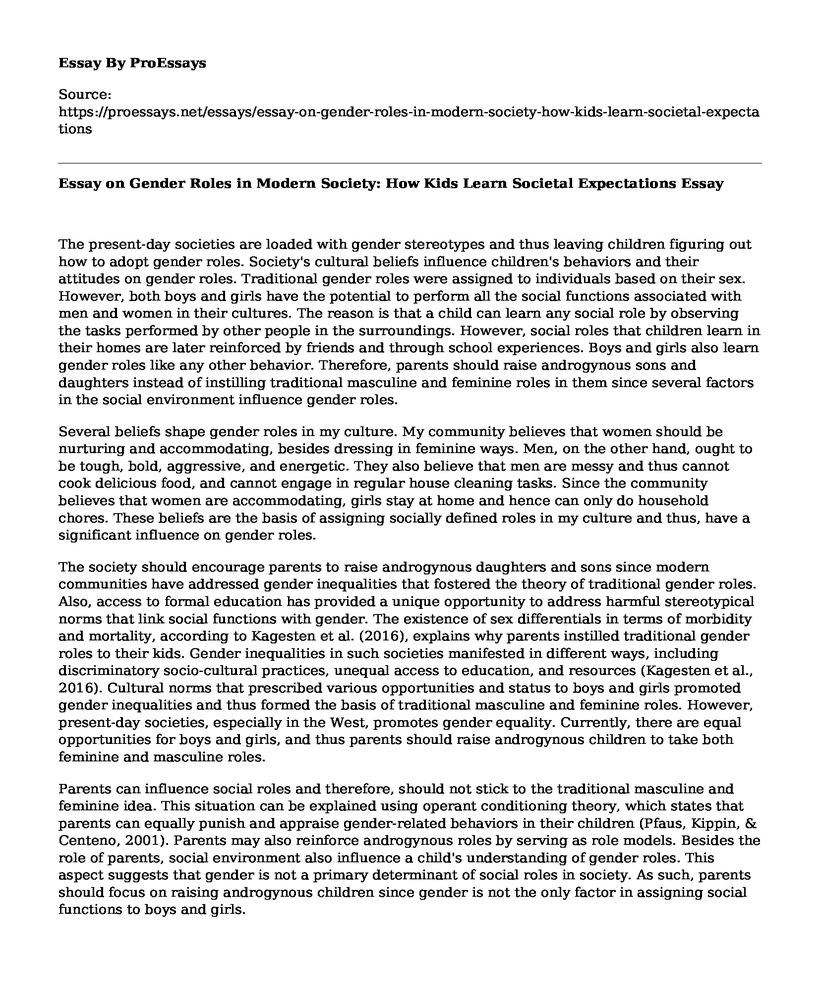The present-day societies are loaded with gender stereotypes and thus leaving children figuring out how to adopt gender roles. Society's cultural beliefs influence children's behaviors and their attitudes on gender roles. Traditional gender roles were assigned to individuals based on their sex. However, both boys and girls have the potential to perform all the social functions associated with men and women in their cultures. The reason is that a child can learn any social role by observing the tasks performed by other people in the surroundings. However, social roles that children learn in their homes are later reinforced by friends and through school experiences. Boys and girls also learn gender roles like any other behavior. Therefore, parents should raise androgynous sons and daughters instead of instilling traditional masculine and feminine roles in them since several factors in the social environment influence gender roles.
Several beliefs shape gender roles in my culture. My community believes that women should be nurturing and accommodating, besides dressing in feminine ways. Men, on the other hand, ought to be tough, bold, aggressive, and energetic. They also believe that men are messy and thus cannot cook delicious food, and cannot engage in regular house cleaning tasks. Since the community believes that women are accommodating, girls stay at home and hence can only do household chores. These beliefs are the basis of assigning socially defined roles in my culture and thus, have a significant influence on gender roles.
The society should encourage parents to raise androgynous daughters and sons since modern communities have addressed gender inequalities that fostered the theory of traditional gender roles. Also, access to formal education has provided a unique opportunity to address harmful stereotypical norms that link social functions with gender. The existence of sex differentials in terms of morbidity and mortality, according to Kagesten et al. (2016), explains why parents instilled traditional gender roles to their kids. Gender inequalities in such societies manifested in different ways, including discriminatory socio-cultural practices, unequal access to education, and resources (Kagesten et al., 2016). Cultural norms that prescribed various opportunities and status to boys and girls promoted gender inequalities and thus formed the basis of traditional masculine and feminine roles. However, present-day societies, especially in the West, promotes gender equality. Currently, there are equal opportunities for boys and girls, and thus parents should raise androgynous children to take both feminine and masculine roles.
Parents can influence social roles and therefore, should not stick to the traditional masculine and feminine idea. This situation can be explained using operant conditioning theory, which states that parents can equally punish and appraise gender-related behaviors in their children (Pfaus, Kippin, & Centeno, 2001). Parents may also reinforce androgynous roles by serving as role models. Besides the role of parents, social environment also influence a child's understanding of gender roles. This aspect suggests that gender is not a primary determinant of social roles in society. As such, parents should focus on raising androgynous children since gender is not the only factor in assigning social functions to boys and girls.
Conclusion
In conclusion, gender inequalities in traditional societies promoted an idea of feminine and masculine roles. Boys and girls, however, have equal opportunities in the modern world. Hence, hyper-femininity and hyper-masculinity should not be the basis of assigning social roles. Gender is not a primary factor that determines a child's gender roles. The reason is that a kid can learn any role by observing the surroundings, interacting, and socializing with other social groups. As such, families should be encouraged to raise androgynous daughters and sons.
References
Kagesten, A., Gibbs, S., Blum, R. W., Moreau, C., Chandra-Mouli, V., Herbert, A., & Amin, A.
(2016). Understanding Factors that Shape Gender Attitudes in Early Adolescence Globally: A Mixed-Methods Systematic Review. PLOS ONE, 11(6), e0157805. DOI: 10.1371/journal.pone.0157805
Pfaus, J. G., Kippin, T. E., & Centeno, S. (2001). Conditioning and Sexual Behavior: A
Review. Hormones and Behavior, 40(2), 291-321. DOI: 10.1006/hbeh.2001.1686
Cite this page
Essay on Gender Roles in Modern Society: How Kids Learn Societal Expectations. (2023, Feb 11). Retrieved from https://proessays.net/essays/essay-on-gender-roles-in-modern-society-how-kids-learn-societal-expectations
If you are the original author of this essay and no longer wish to have it published on the ProEssays website, please click below to request its removal:
- Paper Sample on School Funding
- Essay Example on Paternity Fraud: Misrepresentations and DNA Testing
- Paper Example on Joanne's Right to Safety and Stable Childhood
- Unlock Life's Opportunities With a College Education - Essay Sample
- Essay on School Improvement: Drafting a Strategy for Better Outcomes
- Life's Lessons: Our Unexpected Teachers - Essay Sample
- Research Paper Example on Racial Profiling: A Discriminatory Practice







